
Icon Exhibition


Join us for the Opening Launch of Premonition, by Rod Pattenden on Saturday 17 February, from 2 pm.
This is Rod Pattenden’s second solo exhibition at ASW and promises to be another celebration of sensuous colour and form. Pattenden describes this new body of work as:
New paintings and drawings with a vivid presence and an uncertain future breaking in. Works in vibrant colour, small to large scale with a range of stark large scale charcoal drawings.
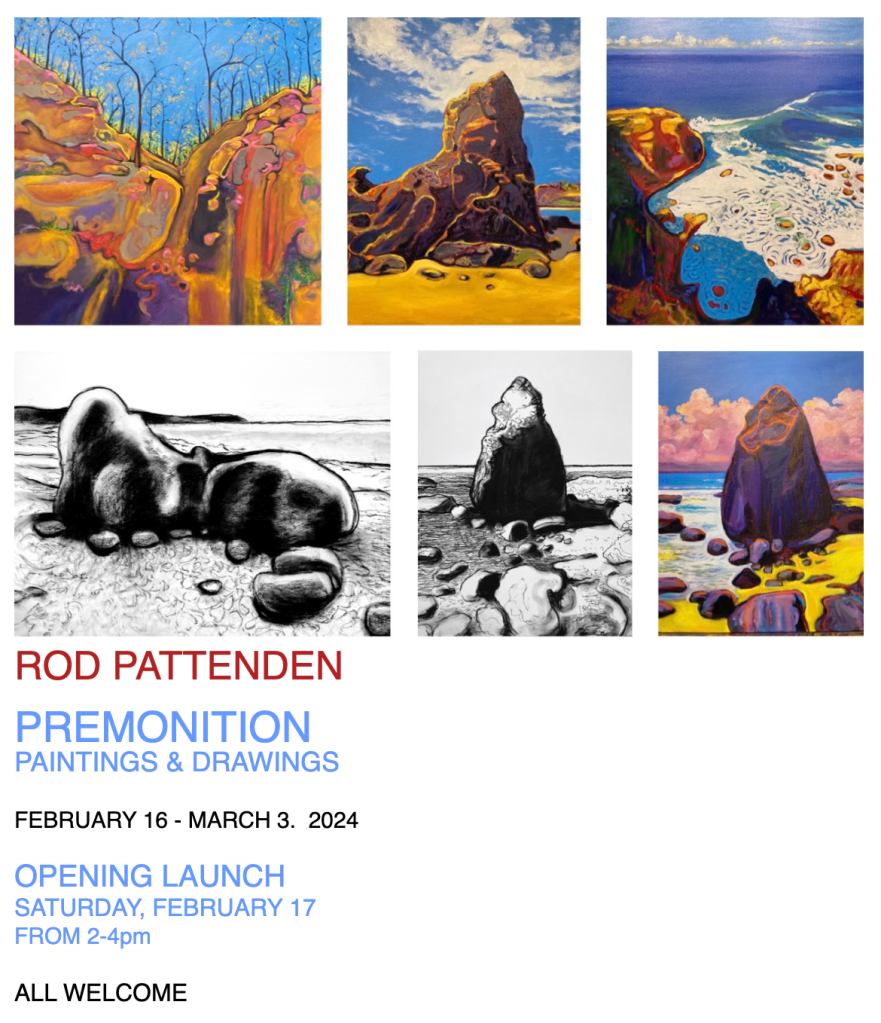

Olga Bakhtina is a Queensland-based artist working in oil and charcoal. She studied painting 15 years ago in the Sultanate of Oman while living there with her family for 4 years. Currently, she studies the history of art at the University of Queensland. Olga has a passion for Early Renaissance art, in which she finds serenity and inspiration.
Since her first solo exhibition in 2012 in Oman, Olga has been exhibiting regularly across Australia. Her recent solo exhibition, ‘Good Samaritan and other Biblical Stories’, showed in St John’s Anglican Cathedral, Brisbane, in July 2023. Olga has been the finalist and winner of a number of Australian Art awards, including the COSSAG (Cathedral of Saint Stephen Art Group) Award in 2016 and 2018.
Olga’s artworks are in the collections of the Archdiocese of Brisbane, the Australian Catholic University, Rosebank College, and St Anselm Abbey, New Hampshire, USA. Her work also hangs in various private international collections.
Olga’s work has been published in various publications worldwide, most recently in The Double: Identity and Difference in Art since 1900 (National Gallery of Art, 2022).
In 2022, the Archdiocese of Brisbane created a video series titled Art Aficionados, in which Olga’s Good Samaritan painting featured:
Olga writes:
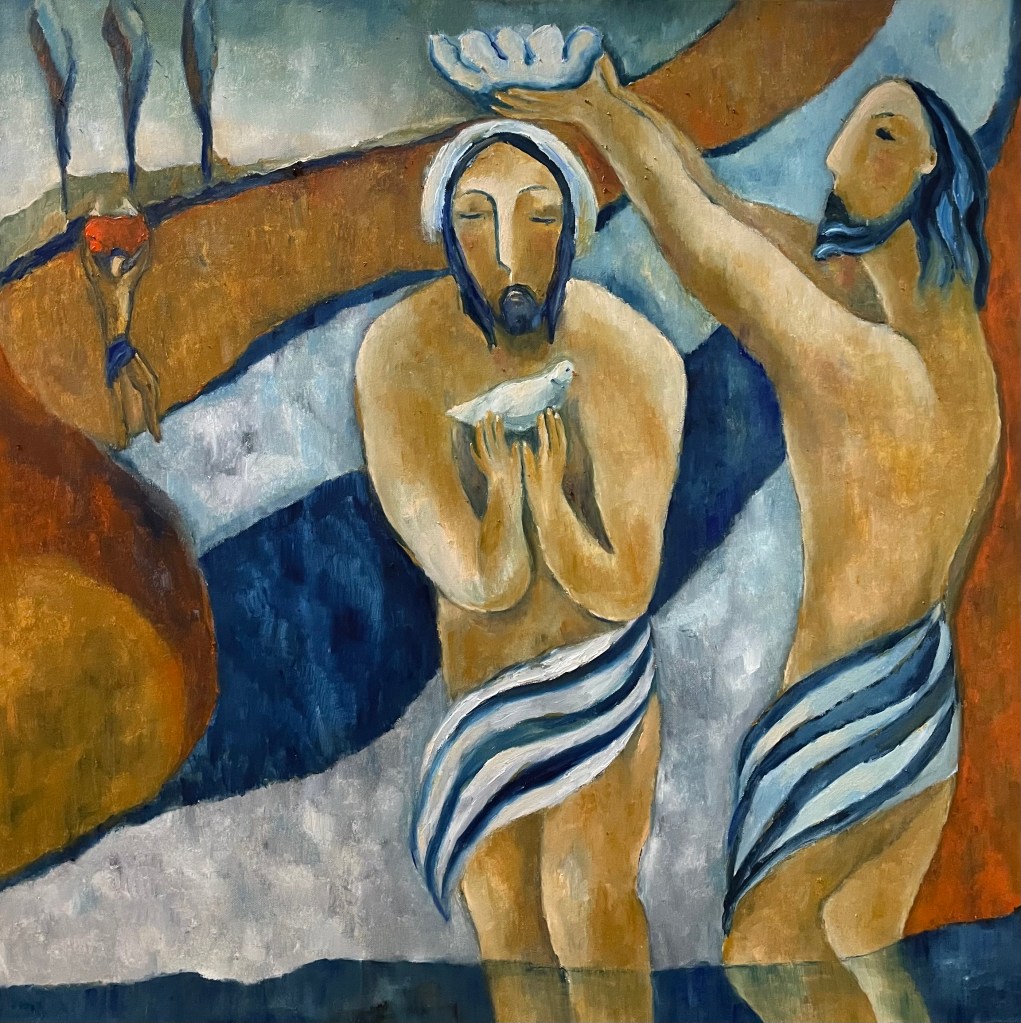
I’m often asked why I paint Bible scenes. There are several reasons, but the most important one is that my paintings are not just about the Bible. They are about humanity and what comes with it – the beautiful things in life, like love, unexpected kindness, devotion, and sacrifice. But humanity also brings pain and tragedy – betrayal, greed, cruelty, and war. Has anything really changed since the Bible was written?
Nowadays it seems that the world is collapsing back to biblical times, as if there is a crack in civilisation. On one hand, there is humanism and advanced technologies, which Joshua, who stopped the sun in the Old Testament, did not dream of. On the other hand, there remains a lot of hate and barbarism, which sadly we continue to see around the world way too frequently. Sometimes, it feels like we’re flipping through the Bible and checking it with our reality.
I think we can all relate to the biblical stories and lessons, in one way or another. The Bible has lots of answers. My biblical paintings are my attempts to find them, to process what is happening in the world, and in my own life. They are my prayers, too. Someone said that art is the highest form of hope.
Olga is having an exhibition as a part of the 150th Anniversary celebration programme of the Cathedral of St Stephen, in Brisbane. The exhibition opens this Friday evening. RSVP to cathedral@bne.catholic.net.au or (07) 3324 3030.
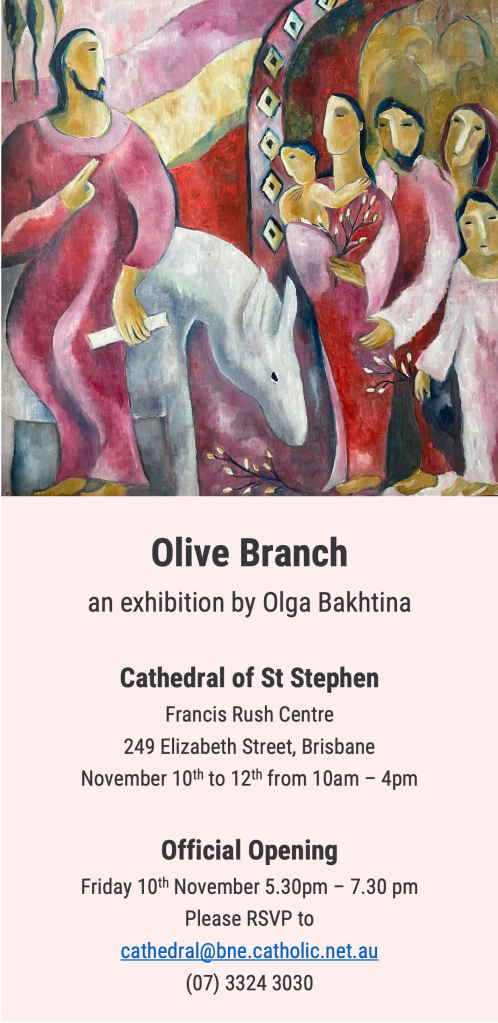
℘℘℘℘
Loud Sky is an exhibition of works by five artists who have responded to engagement with survivors of institutional child sexual abuse. This engagement has included direct conversations, the recounting of stories of survival, the sharing of treasured objects, and, in some cases, the direct involvement of survivors in the making of the final artwork. The lives of survivors are made visible and imprinted in and through the works commissioned especially for this exhibition. Loud Sky is a term borrowed in part from the Loud Fence movement, which began in Ballarat in 2016 and has now gone around the world, where ribbons have been tied on church fences as a form of memory making, protest, of visualising loss, and also a celebration of human life. Loud Sky seeks to visualise the story of those impacted in the Hunter Region, honouring their courage, resilience, and instincts for survival. Institutional child sexual abuse has had a profound and far-reaching impact on this region and has directly affected the lives of many thousands of people. This exhibition gives expression to these human stories, giving them a voice and a form of visual presence. Despite the horror of abuse, these works visualise courage, containing elements of profound and great beauty.

This sense of imprinting is found in the strategy developed by Clare Weeks, where she invited survivors to take a sheet of plain paper and imagine themselves writing a word that expresses their sense of resilience and hope. She invited respondents to fold or crease this paper into an enfolded form. Each of these was then documented through a process of numbering, unfolding, and photographing their surface and then refolding them to their original condition. Each scanned surface reveals unique, idiosyncratic, and textured features. Thirty-two members of the survivor community responded to this invitation, and each is treated with reverence and importance as objects that contain memories of great significance. They each carry a fragile delicacy and beauty. Each fold is unique and particular. This record of the physical process of remembering reminds us of the manner in which we fold up what is most precious to us. We carefully enfold our hopes as precious possessions, keeping them safe, tucked neatly below our rib cage. Clare Weeks draws attention to the manner in which human memories are transferred to objects, things we hold dear that become relics or tokens of hope that empower a sense of resilience. These are delicate and beautiful objects that reveal, as through a veil, a remarkable expression of hope.

Objects that serve as vessels for memory are evidenced in an even more distilled form through the eloquently rendered drawings of Damien Linnane. Inviting survivors to share a treasured object, the artist calls for our sympathetic engagement with objects that carry a form of empowerment that aids survival. These are objects alive with resonant significance that amplify human hopes, ambitions, and pleasure. They represent relationships of love, playfulness and achievement. These are objects of power. When so much else has been taken away from survivors in their childhood, these objects operate as rudders for hope to be touched, held, and found in the present moment as a tangible form of resilience. Linnane’s drawing technique gives these objects a striking visual presence as each surface is delicately observed so that the light seems to emanate from within. These are lovingly rendered, and we sense the delight, interest, and commitment of the artist as we follow with our own eye each mark and gesture that gives life and presence to otherwise inanimate objects – these things that are alive with memory. It is a privilege for the viewer to be given intimate access to this treasured relic and its capacity for hope.
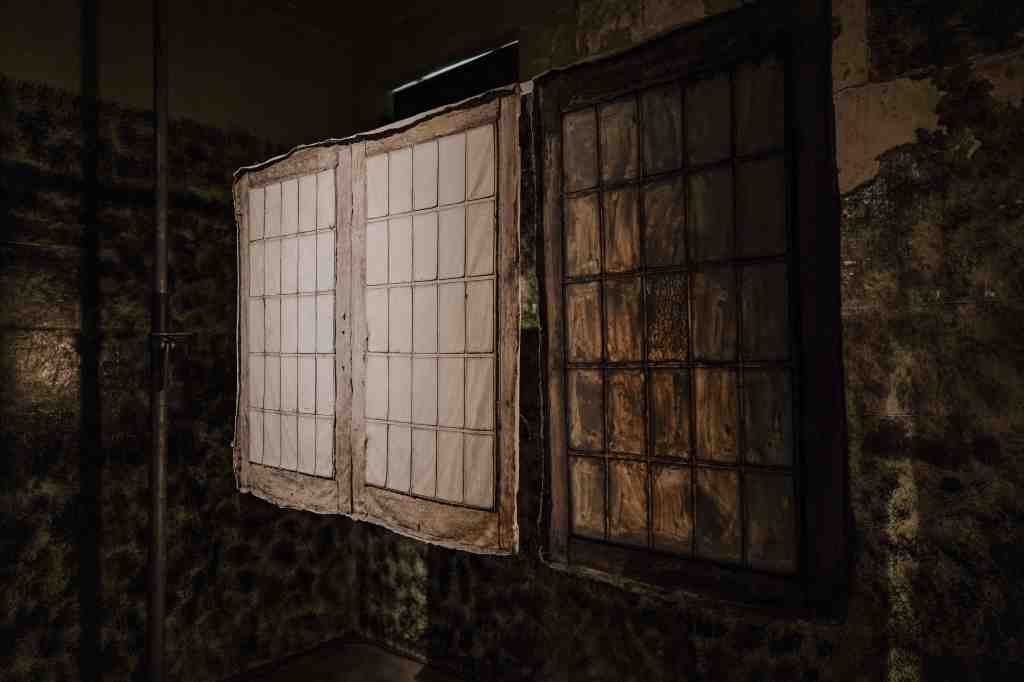
Fiona Lee’s work presents the softly lit form of three casement windows. The viewer is placed in a stance of both looking out and looking in. This is a space of hovering decision-making about where to focus one’s attention. The particular form of the work came as a response to a question the artist asked survivors about what motivated them to begin their day, which more deeply frames questions about life’s purpose, and finding the energy for action. Honest, straightforward answers included the choice to stay in bed, or to reach towards relationships of love, or the mundane responsibilities that accompany being in community. The material of the window is a latex mould. It is like a skin, or a print, of a lead-lined casement window. It materialises the question we face at the beginning of every day – every plan, every hope, and every action – of whether it will be worth the effort to engage this day, this opportunity. To open this window involves risk, the potential for change and loss, and also the fresh air of new possibilities. Every window has this quality of beckoning the imagination. Their frames of tight geometry play out a matrix of fear and expectations, or they provide escape, freedom, or hope without restraint. This particular window holds us in the moment of decision-making, with the question of where this day might lead.

Peter Gardiner brings us into the searing presence of light and heat. The fire is a metaphor for danger and catastrophe that appears out of the darkness with the lighting of one match. This is the wildfires ignited by the Royal Commission that resulted in over 8,000 recorded testimonies of institutional abuse. There was smoke, as things were rumoured, that now appear in the light for all to see. However, the full force of this grand scene is held in check. We can observe the impact of the fire from a safe distance and begin to see that within the fire, there is the possibility of survival, renewal, and a new order of things. Fire not only destroys; it also brings new life to the environment; it purifies, transforms, and renews; it turns from red into gold. Gardiner’s work carries both horror and hope. We are in the presence of some immense catastrophe that will change how we live well into the future so that this does not happen again. It is an active vigilance towards justice that arises from a community having been confronted with the truth. No longer is there a tolerance for darkness, as there can only be light, even if it threatens to burn.
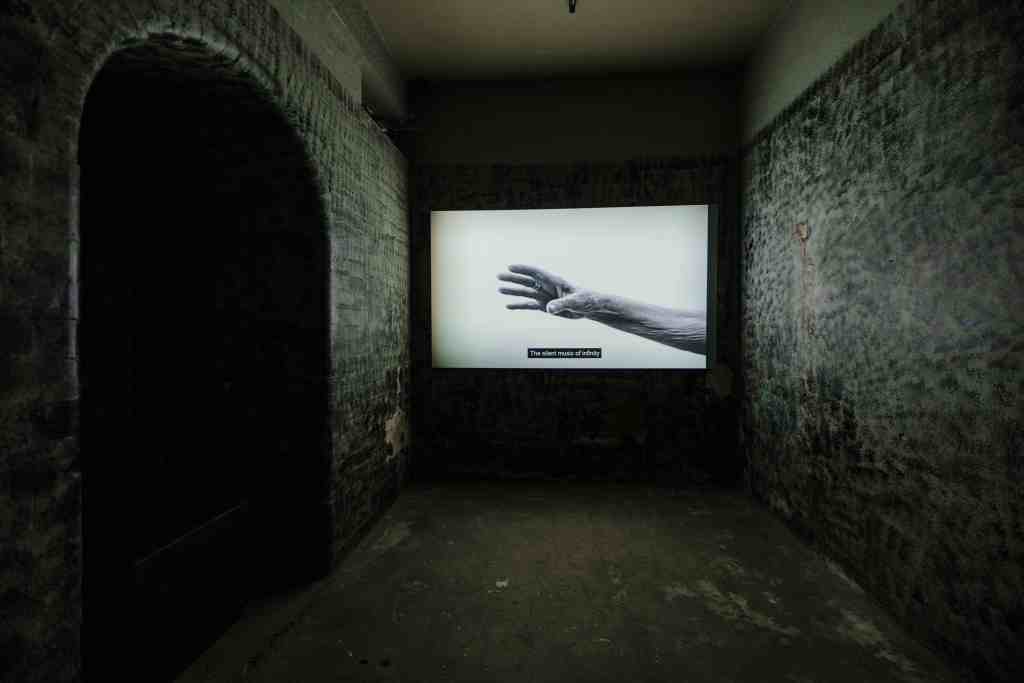
Lottie Consalvo’s work is a collaboration with a survivor, and his wife, around the question of what has sustained their lives. It offers a meditative exploration through silence and slow-moving gestural forms. The video-based work carries a grainy texture like paint, slowing our looking towards a more considered and contemplative place. We are in the presence of a human life, but one where each gesture becomes magnificent, primal, and beautiful. There are passages where an arm reaches out in ritual-like action, perhaps reaching for something, and then, at other times, a gesture of letting go. Without a narrative structure, the viewer has to put together this work in their own imagination as we follow the subtle shifts of gesture and the phrases of text that evoke states of silence. The artist invites us to be present as viewers of the simple beauty of silence at the heart of human existence. This is the invitation to be still and to be quiet, to have nothing, and to have everything, all at the same time. This is a space beyond fear, manipulation, and anxiety, where a human being might thrive in and through the small gestures of living. This is finding a life worth living and being grateful for that because it is enough. The silence of this work speaks with eloquence. It amplifies the beauty of being human.
This exhibition includes a timeline that lays out the history of the emerging public awareness of the abuse as well as television footage of these events as they unfolded. Words by family members of survivors that record the impact on their lives are also included, as well as a series of school photos of victims, not all of whom have survived. Against this dark and difficult reality, the work of the five artists commissioned for this exhibition offers something tangibly beautiful about the nature of being human. What comes to light is the courage and resilience of victims and survivors.

A final expression of the exhibition’s aims was the installation of around 7,000 ribbon flowers on the grounds of both the Catholic and Anglican Cathedrals in Newcastle. Made by survivors, friends and family, and community and church members, they are an act of remembering victims and survivors. They express a desire for truth-telling and community healing. Art provides the resources to approach experiences of horror and disintegration in a manner that brings deeper understanding, shared compassion, and the possibility of a more hopeful future.
Loud Sky is on exhibition at The Lock Up Contemporary Art Space in Newcastle until 21 May.
℘℘℘℘
When words fail me, being in the studio helps me make sense of the world.
This new body of work emerges from several years of attending more deeply to the life of the trees that surround and companion me every day. For many years, I have walked routinely along a path that follows a local creek, appreciating how the trees continue to hold space for me. Even as the weather changes and shapes them, we both endure. But in late 2021, I watched my neighbour excavating the land nearby and, by doing so, undermining the existence of a healthy gum tree. As the roots of this tree were laid bare, I went into the studio to paint the grief that I felt and understand the depth of my response to the inevitable loss of this tree.
It seems that in choosing to live among trees, we live within a nexus of risk and power. In being among the trees surrounding my studio as I make this work, I am becoming more deeply aware of the interdependence that shapes our life with trees. Trees welcome the CO2 that I cannot bear and, in turn, offer me life in the form of oxygen. As I learn to see how trees live interdependently with one another, I see a healthy exchange between risk and power, shaping how I can choose to live with others. I am learning to see trees in the way I see people, and I am wondering what it is like to be a being among trees.
Over the past year or so, I have been working towards developing a new exhibition set to be hung in April 2023.
Being Among Trees will hang in the Queen Victoria Women’s Centre between 3–27 April. Rather than an opening night, I have scheduled an afternoon for a conversation with the artwork and me. Further details are below:

℘℘℘℘

The exhibition Rituals of Embodied Knowing brings together ten established artists with diverse forms of practice that engage plants, video, sound, movement, painting, drawing, and installation. These artists have been working together with an academic group on the project ‘Spiritual Understanding in a Secular Age: Engaging Art as Religious Ritual’, funded by the Templeton Religion Trust.
The project conceptualises art-making as a form of knowledge or understanding that aims to make contact with various aspects of reality such as the natural world, human history, and our individual selves, thus considering how art-making practices in a secular context might, when seen in this way, share similarities with religious ritual.
Academics from a variety of fields such as history, anthropology, psychology, sociology and theology, have identified how key dimensions of each of these practices – movement, time, media, subtraction, invention, and attention – are also leveraged in religious rituals to make contact with reality.
The project calls on us to see art-making in a new way, and has also challenged academics to see aspects of reality in new ways through engaging art-making itself as a means of knowing and understanding. This exhibition invites viewers to consider whether and how the works included could be thought about as ritual-like in their unique ways of employing embodied experience.
This exhibition also launches the new CBONE Gallery, combining the previous Eastgate Gallery and Chapman and Bailey project space into one entity that will show a range of contemporary visual art.
Joining the project artists, Heather Hesterman, Adam Lee, Louise Weaver, Dominic Redfern, Harry Nankin, Chris Bond, Peter Ellis, Mark Newbound, Live Particle, and Sarah Tomasetti, are Yolngu artist Djirrirra Wunnumarra and emerging artist Uma Christensen.
An edited volume of essays emerging from the project will be published in 2024.
Exhibition Dates: 18 February – 18 March 2023.
Where: CBONE Gallery, 1C Marine Parade, Abbotsford, Melbourne.
Live Particle (Angela Clarke and Camilla Maling) will be presenting a series of Soma Scores using their unique sensory objects to generate embodied experience on Saturday 11 March.
There will be a discussion panel and closing event on Saturday 18 March.
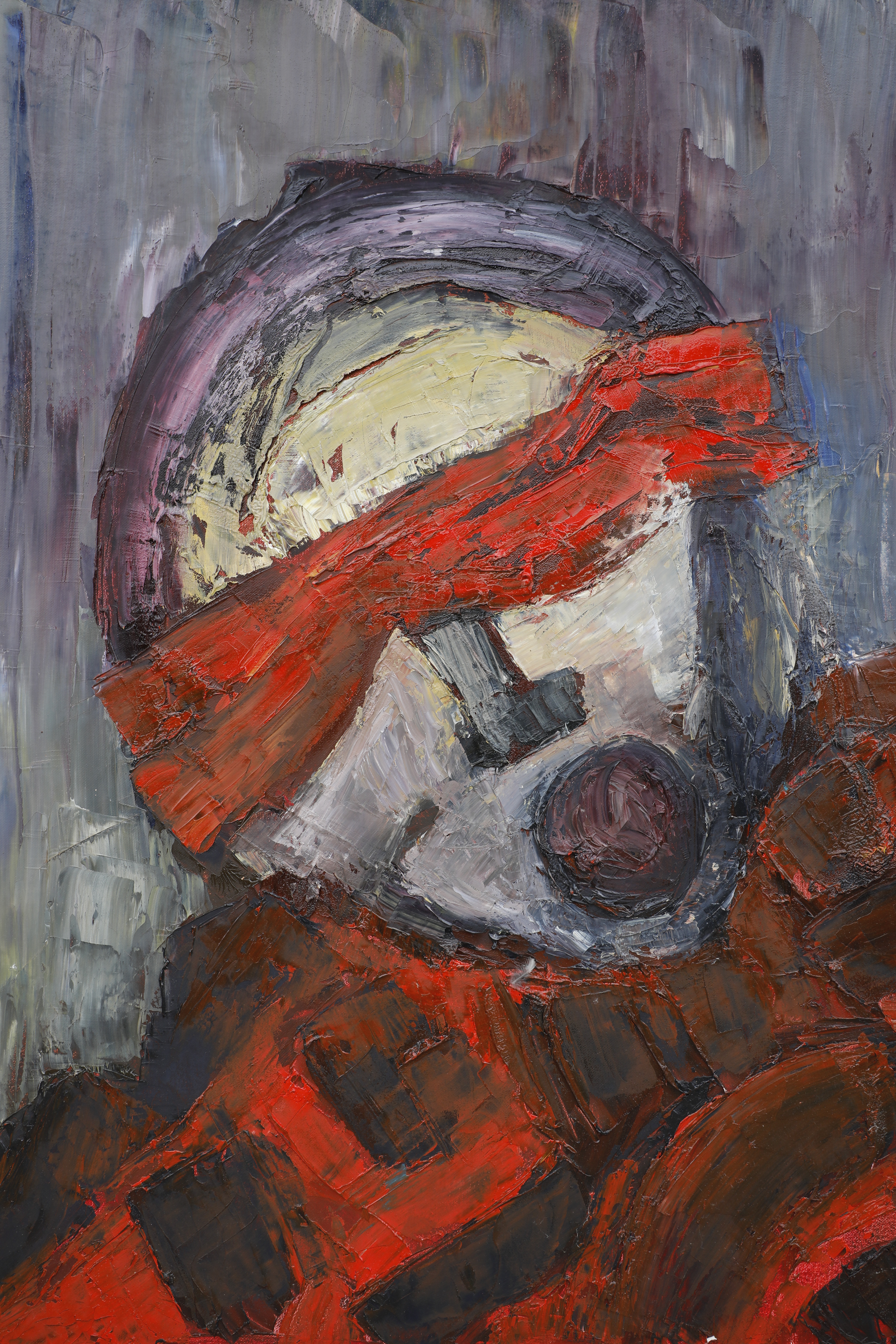
Last month, Jason Goroncy spoke at the opening of an exhibition of Wes Campbell’s artwork. Wes is a theologian, artist, and (retired) Minister of the Word in the Uniting Church in Australia. An edited version of his talk is now available on the ABC’s Religion and Ethics portal.
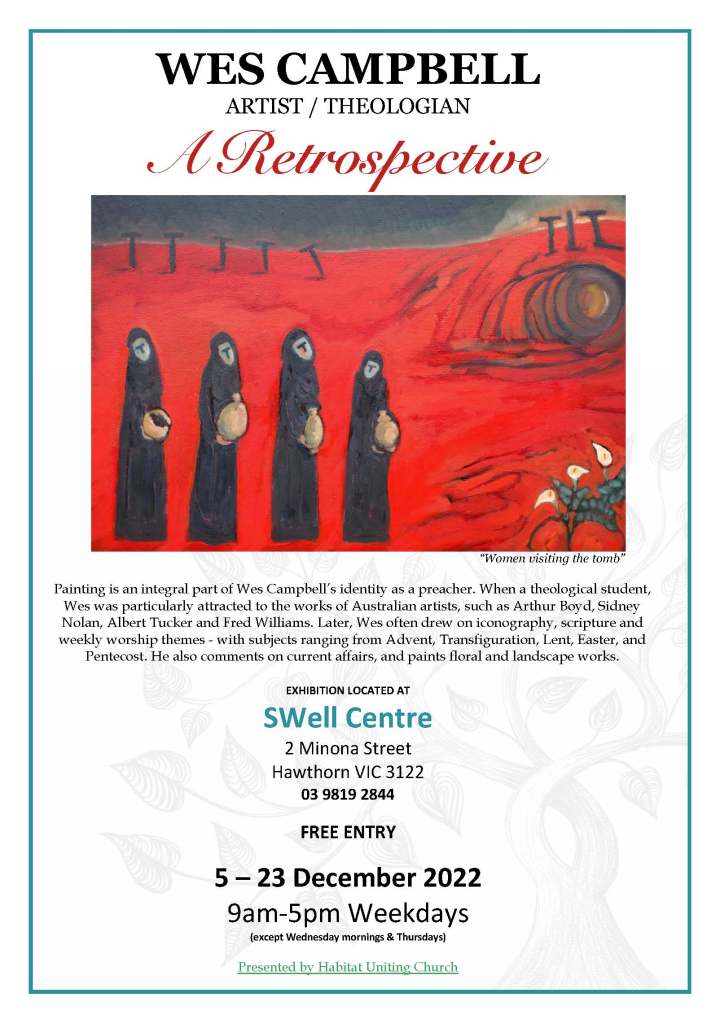
Mandorla Art Award 2022. Theme: Metamorphosis (Isaiah 43.19)
In describing the winning artwork for this year’s Mandorla Art Award, the judges said:
The prophetic imagination invites us to lay aside old ways of being and sources of authority, and to imagine new futures.

Claire Beausein, who divides her time between Broome and regional Victoria, formed her work by stitching together over 600 wild silkworm chrysalises gathered from the wild in Indonesia. Chalice is a powerful work that draws you in close to experience the glorious sheen on the work and the lace effect of the shadow and to stand away from it and see the possible image of a face that some have described as the face of Christ. Claire began her exploration with thoughts of a shroud which symbolises the metamorphosis of the human person into eternal life. From there, her thoughts developed into a search for wild cocoons. The colour range is from gold to very pale yellow, and they are carefully patterned. Claire described the process of putting the artwork together as a meditative act. Some of the silk thread used to assemble this work is intentionally visible on the surface but much of it is hidden as is so much of our spiritual development. Our various spiritual metamorphoses in life are often hidden from sight but seen in effect and in our witness to what has occurred within. The work is suspended by museum pins, reminiscent of the moths and butterflies displayed as collections, standing away from the cotton rag paper background. The curved shape of the lower edge speaks of the shape of a chalice which holds the wine to be transformed and the gold colour also speaks of sacred vessels. Claire speaks of the ‘gravitas of profound change with the fragility of lace’. These opposites are in tension as in our spiritual lives.
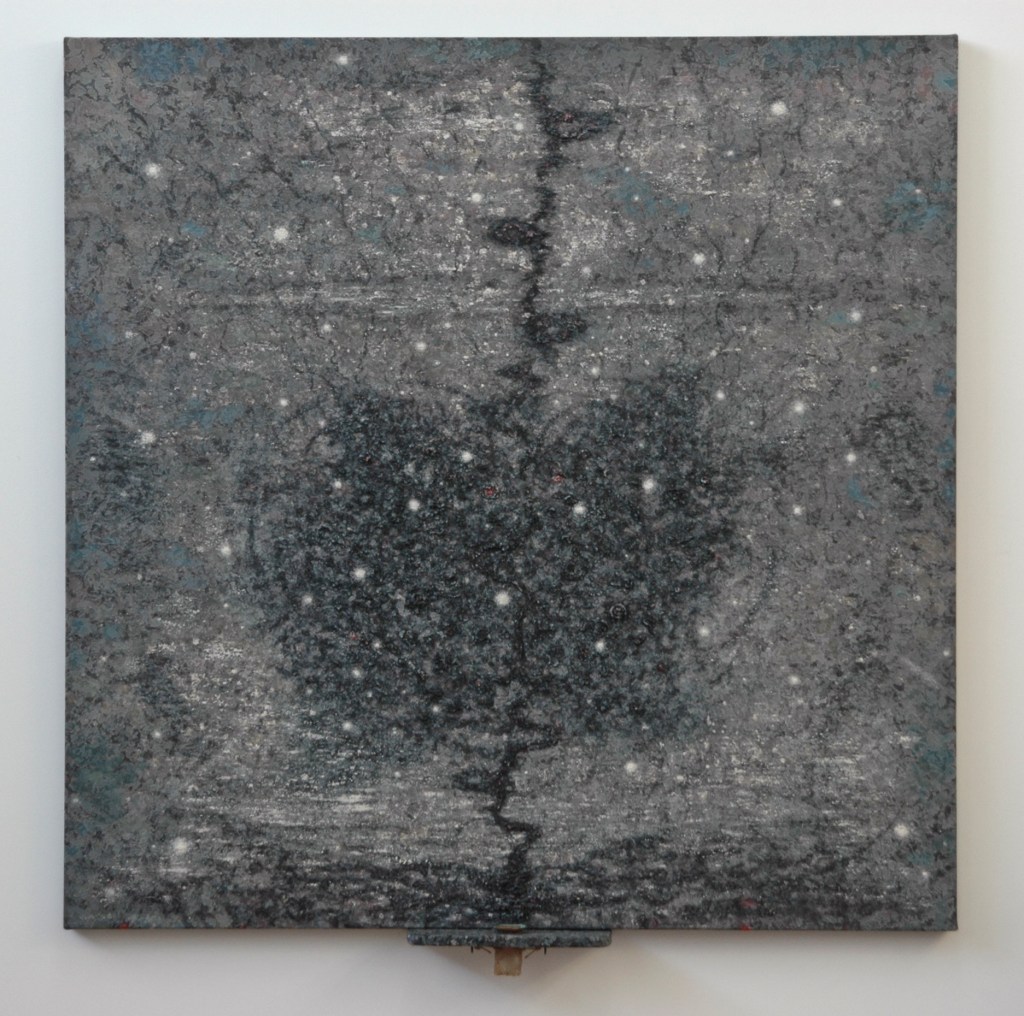
Michael Iwanoff’s work, fromlittlethings, evokes the endless nature of change in all of creation, including within ourselves. He describes it as a ‘poetic meditation on the transformative seed each of us is able to sow into our awareness, experience and life’. The whole of creation is in the process of continual transformation, metamorphosis, as Paul says: ‘We know that the whole creation has been groaning in labour pains until now’ (Rom. 8.22). When the work of God is finished, when the whole of creation has been returned through the glory of Christ, we shall all be one in God. What is required is to wait in hope. In fromlittlethings the hope is symbolised by the seeds held in a small bag at the base of the painting, hanging from a mantle on which there is a small copper bowl from which water evaporates. There is so much in the work that is symbolic of all manner of change, some of which we are subjected to and some that naturally flows from our very nature. In the judges’ description, they spoke of the painting holding themes of ‘homecoming, journey, and acceptance’. There is a cosmological level too in the semblance of stars, and at different angles one catches a small glittery flash of light. In Michael’s description, he speaks of ‘this metamorphosis that is honoured and that so exquisitely grows the joy of being’.
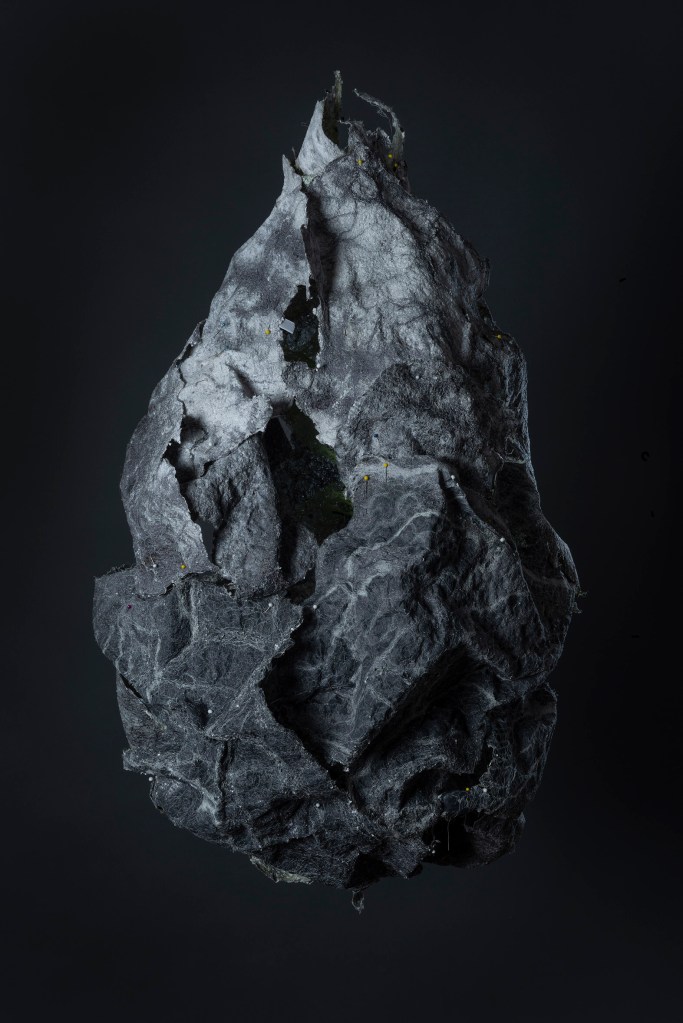
Terre Verte, a particular green pigment, is revealed in the central section of Susan Roux’s free-hanging work. She begins her description with: ‘Adrift in rivers that divide and bind lands, I chart a home anew’. Susan’s original material for this work was a series of maps which symbolise the journey upon which she has personally embarked, and the journey of life that we all travel. The maps were washed and dried and stitched on a sewing machine using a completely free form of working the material. It is an extremely laborious way of building a fabric but the effect is rich and unpredictable. For Susan, it is also a deeply meditative way of working. There are structural wires inside that speaks of our own physical structure, our skeletal strength that is unseen but completely necessary for our embodied life. As the judges said:
Viewed from a distance the piece is reminiscent of a rock, geode, or even a distant universe, evoking an almost geological sense of time-scale and transformation.
Inside, however, the terre verte, the green thread used in free stitching on a material that is then washed off the stitching leaving a lace effect, is burgeoning forth. Life and creation continue in the green, growing heart of her work. This is the sense of Spirit, of re-creation, that Susan seeks. The metamorphosis marks many places in our journey. The great metamorphic actions in scripture include Abram’s journey west, the exodus from Egypt, the exile in Babylon and the return, and, of course, the life, death, and resurrection of Jesus. For Christians, there are many changes along the way, but the greatest is our baptism where we are changed into a new creation in Christ.
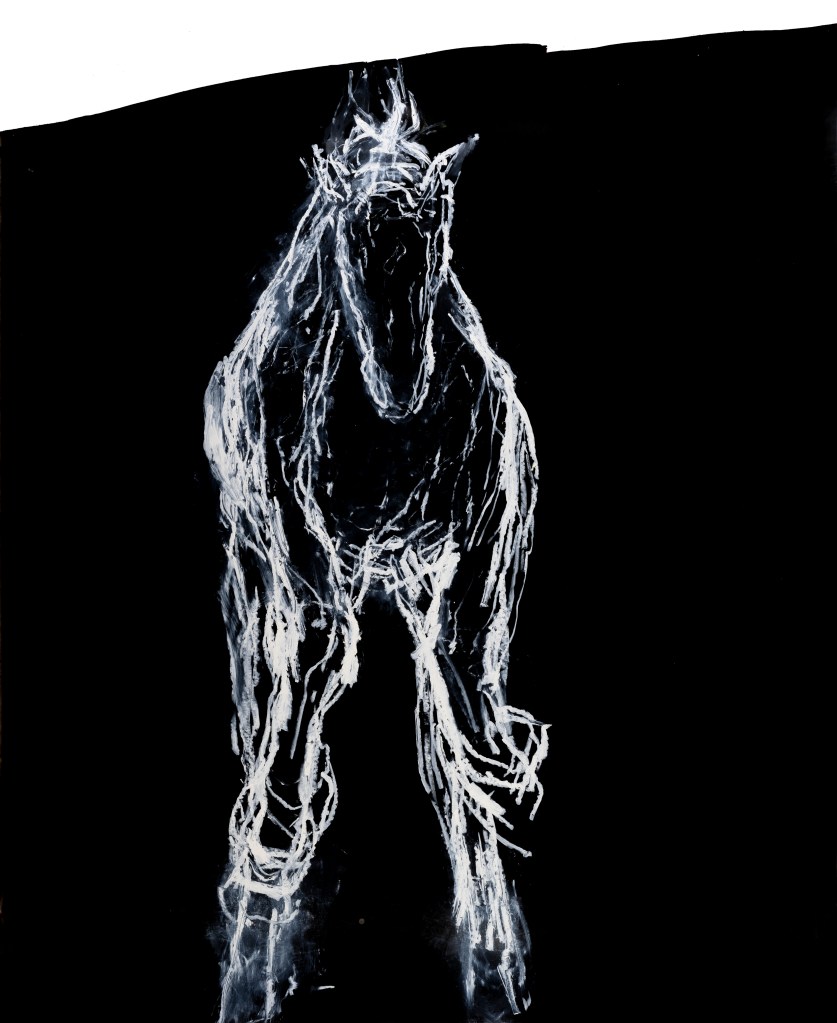
Angela Stewart’s artwork confronts you from the full distance across the gallery in the opening exhibition. There is a sense of compulsion and a desire to know the story. Her artist’s statement centres around grief, death, silence, love, loss, helplessness. Two years ago Angela’s son, a horseman, died. This artwork depicts the growth from out of the loss, the metamorphosis that grief insists upon. She will never be the same, but the horse is the symbol of the strength needed to get out of the depths of loss. It is a powerful work. In the Hebrew scriptures, the images of horses are important. If you had a horse, you went into battle with a better chance of survival than if you were on foot. In Psalm 33.17, however, we hear that the ‘war horse is a vain hope for victory, and by its great might it cannot save’. If we rely only on the things around us, the things we wrap our humanity and strength in, then we will not be rescued from our distress. It is these times that trust in the Lord is required and a time for us to move through the grief, as Angela says, to ‘recalibrate, begin, breathe, the horse, the rider, my son’. The judges’ comments say this succinctly:
The insistence of the image to be expressed captures the unstoppability of the prophetic voice – of the Divine voice – arising in unexpected places, disturbing and comforting, undeniable. This technically accomplished work plays with the inversion of light and dark, and evokes movement and disquiet with multiple images, ragged edges, and lines pulsing with energy.
The array of artworks for the 2022 Mandorla Art Award each offer us a way in which to view the theme of Metamorphosis – a profound or radical change. ‘I am about to do a new thing; now it springs forth, do you not perceive it?’ (Isaiah 43.19). In times of discontinuity, faith becomes an important ingredient, and this has been evident in times of radical change. With the pandemic, we have all experienced the need for change, and war and climate change continue to impact us all. Yes, we need to change and the challenge is to make it positive on the large scale as well as the small. The artists chosen as finalists gave expressions of metamorphosis that are both challenging and beautiful.
℘℘℘℘
